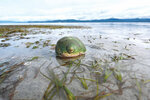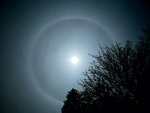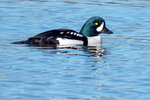


For all our handwringing about the sun and what it is or isn’t doing, it is the moon, lustrous and unsought, that has the power to haunt the mind’s eye.
A friend who lives on Crescent Beach remembers an evening three decades ago, when she was a kid, when she walked the beach south at dusk with her mom and her mom’s friends. They came to the point and the moon appeared over the trees. “It was huge, low, glowing the most intense orangey-yellow color. I can still see it in my head. It was stunning.”It was also her first lesson on the speed of tides during a full moon. The onrushing tide forced them up against a bulkhead. On tiptoes on a narrow concrete ledge, they reached for the lip of the wall and hauled themselves up — such an adventure for a kid.
The moon’s dance with tides goes beyond the twice-high, twice-low daily rhythm. Tides have been described as the world’s largest waves. As these gigantic masses of water move, they change the distribution of Earth’s weight. Earth’s gravity holds the moon in orbit, and the shifting nature of Earth’s mass — caused by the moon’s own gravity working on Earth’s tides — serves to destabilize the moon’s orbit, pushing it away from Earth at the rate of an inch and a half per year.
The moon also wobbles. On an 18.6-year cycle that has been recognized for hundreds of years, its position relative to Earth oscillates, enough to slightly dampen tides in the lower part of the cycle and slightly amplify them in the upper part. Right now the moon wobble is amplifying tides, nudging them higher and lower. But it is moving toward the lower part of the cycle. So the next decade will see a dampening of so-called sunny day floods, where seawater without storm surge creeps over the rims of our beaches, and the 2030s will see those floods boosted, just as climate change really starts to push sea level higher.
Where else has the moon left its faint tracks on our landscape?
I think of moon snails first: roving moons all over the sandflats. On the prowl, a moon snail enfolds itself in its muscular body, shapes it like a plow, greases it with mucous, and cruises under the sand for clams, which it bathes in a calcium-based acid before drilling distinctive counterbored holes through the poor beasts’ shells.
Moon snails couple under the sand too. After mating, a female exudes mucous to bond the surrounding sand into a collar-shaped mold of herself. She scatters thousands of tiny eggs against the collar. She repeats the mucous trick. The double-layered collar, eggs sandwiched in the middle, protects the eggs until they hatch into free-swimming plankton. A moon snail can live over a decade.
Then we have the moonglow anemone, a sand-bound creature that acts almost more like a geoduck than an anemone. It anchors itself deep under the surface of the sand and stretches its body to the top of its hole to feed. It retracts when it is bothered or exposed. Being stuck in place, moonglow anemones must mate by broadcasting their gametes to the seven seas. They somehow synchronize this mass spawning. I wonder if the timing is related to the moon and tides. But if sexual reproduction doesn’t work, a moonglow anemone can always duplicate itself by splitting lengthwise.
Slowly, slowly naturalists are picking up on nocturnal rhythms, recognizing the power of the moon to shape life. If you are a small nocturnal mammal, your night under a full moon looks quite different than a night in darkness. You’ll stay closer to shelter, eat less, move less. If you’re a coyote or bobcat you’ll shift your waking hours and sometimes the target of your hunt. A study on red foxes found their diet to be highly dependent on moon phase.
Moths seem to respond to the moon, some with their mating flights, some with their migrations. But using the moon as a navigational aid ought to be impossible: the moon’s tilted orbit means it rises at a different heading every night. Recent research indicates some moths nonetheless make their moon compass reliable by pairing it with an ability to read Earth’s magnetic field, which remains fixed and calibrates the moon’s position.
I’d guess that the Key Peninsula’s highest concentration of selenophiles — moon lovers — is at Crescent Beach. It makes sense. My friend describes how the moon hangs in the vast expanse of the western sky, just above the Olympics, sometimes its reflection on the water so bright she wakes up thinking it is morning when it is the middle of the night. In Turkish the word for the moon’s long reflection on water is gümüş servi, meaning silver cypress. In Swedish it is mångata, moon street.
Those millions of shining ripples, like the leaves of a cypress, or cobble-stones of a street, are sometimes laid over literal millions of the last lunar creature I can conjure: the moon jellyfish. In late summer and fall, South Puget Sound can host blooms of this translucent jelly massive enough to be visible from aircraft. The biggest blooms seem to be correlated with periods of higher water temperature and salinity, such as during the infamous Blob of 2014-15. But there is much variability — yet another complex rhythm we have yet to fully grasp. When the moon jellies are in, they are in. Under a boat, they turn a bay’s water into a drifting, shifting galaxy.
UNDERWRITTEN BY THE FUND FOR NONPROFIT NEWS (NEWSMATCH) AT THE MIAMI FOUNDATION, THE ANGEL GUILD, ADVERTISERS, DONORS AND PEOPLE WHO SUPPORT INDEPENDENT, NONPROFIT LOCAL NEWS